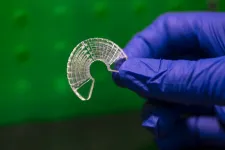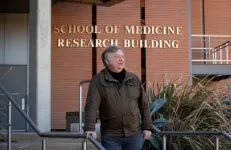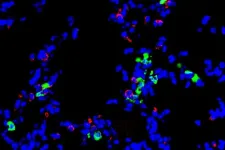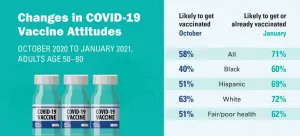Researchers use silkworm silk to model muscle tissue
Transgenic silk proves to be effective surface for 3D muscle modeling
2021-03-09
(Press-News.org) News Release -- LOGAN, UT -- Mar. 9, 2021 -- Researchers at Utah State University are using silkworm silk to grow skeletal muscle cells, improving on traditional methods of cell culture and hopefully leading to better treatments for muscle atrophy.
When scientists are trying to understand disease and test treatments, they generally grow model cells on a flat plastic surface (think petri dish). But growing cells on a two-dimensional surface has its limitations, primarily because muscle tissue is three-dimensional. Thus, USU researchers developed a three-dimensional cell culture surface by growing cells on silk fibers that are wrapped around an acrylic chassis. The team used both native and transgenic silkworm silk, the latter produced by silkworms modified with spider silk genes.
Native silkworm silks have been used previously as three-dimensional cell culture models, but this is the first time that transgenic silkworm silk has been used for skeletal muscle modeling. Elizabeth Vargis, Matthew Clegg, and Jacob Barney of the Biological Engineering Department, and Justin Jones, Thomas Harris, and Xiaoli Zhang of the Biology Department published their findings in ACS Biomaterials Science & Engineering.
Cells grown on silkworm silk proved to more closely mimic human skeletal muscle than those grown on the usual plastic surface. These cells showed increased mechanical flexibility and increased expression of genes required for muscle contraction. Silkworm silk also encouraged proper muscle fiber alignment, a necessary element for robust muscle modeling.
Skeletal muscle is responsible for moving the skeleton, stabilizing joints, and protecting internal organs. The deterioration of these muscles can happen for myriad reasons, and it can happen swiftly. For example, after only two weeks of immobilization, a person can lose almost a quarter of their quadricep muscle strength. Understanding how muscles can atrophy so quickly must begin at a cellular level, with cells grown to better represent reality.
"The overarching goal of my research is to build better in vitro models," said Elizabeth Vargis, associate professor of biological engineering at USU. "Researchers grow cells on these 2D platforms, which aren't super realistic, but give us a lot of information. Based on those results, they usually transition into an animal model, then they move onto clinical trials, where a vast majority of them fail. I'm trying to add to that first step by developing more realistic in vitro models of normal and diseased tissue."
INFORMATION:
[Attachments] See images for this press release:

ELSE PRESS RELEASES FROM THIS DATE:
2021-03-09
COLUMBUS, Ohio - A new SARS-CoV-2 vaccine candidate, developed by giving a key protein's gene a ride into the body while encased in a measles vaccine, has been shown to produce a strong immune response and prevent SARS-CoV-2 infection and lung disease in multiple animal studies.
Scientists attribute the vaccine candidate's effectiveness to strategic production of the antigen to stimulate immunity: using a specific snippet of the coronavirus spike protein gene, and inserting it into a sweet spot in the measles vaccine genome to boost activation, or expression, of the gene that makes the protein.
Even with ...
2021-03-09
Delaying second doses of COVID-19 vaccines should reduce case numbers in the near term. But the longer-term case burden and the potential for evolution of viral "escape" from immunity will depend on the robustness of immune responses generated by natural infections and one or two vaccine doses, according to a Princeton University and McGill University study published March 9 in the journal Science.
"Several countries including the United Kingdom and Canada have stated that they will delay second doses of COVID-19 vaccines in response to supply shortages, but also in an attempt to rapidly increase the number of people immunized," said lead author Chadi Saad-Roy, a Ph.D. candidate in Princeton's Lewis-Sigler Institute for Integrative ...
2021-03-09
Members of the COVID-19 Primary Care Database Consortium explain how the use of big data containing millions of primary care medical records provides an opportunity for rapid research to help inform patient care and policy decisions during the COVID-19 pandemic. Established in April 2020, the Consortium brings together experts in big data, epidemiology, intensive care, primary care and statistics, as well as journal editors, patient and public representatives, and front-line clinical staff from the universities of Oxford, Cambridge, Southampton, Bristol and Nottingham
The consensus statement that the consortium has developed and described in the article aims to facilitate transparency and rigor in methodological approaches, as well as consistency in defining and reporting ...
2021-03-09
Members of the Perelman School of Medicine at the University of Pennsylvania and its health system developed and implemented a new model of collaborative care called The Penn Integrated Care (PIC) program. PIC includes a resource center to support intake, triage and referral management and collaborative care services in primary care practices. PIC was created to increase access to and engagement with mental health professionals to improve mental and physical health outcomes. Primary care physicians were able to refer patients with any mental health symptom or condition to PIC. In 12 months, 6,124 unique patients were referred from eight primary care clinics to either the PIC Resource Center or were connected with a mental health professional. ...
2021-03-09
RIVERSIDE, Calif. -- Variants of the coronavirus are appearing in different parts of the world, many of them spreading with alarming speed. One contagious variant is the South African, or SA, variant, identified by an international team of researchers, including biomedical scientists from the University of California, Riverside.
"The new COVID-19 variants are the next new frontier," said Adam Godzik, a professor of biomedical sciences in the UC Riverside School of Medicine and a member of the research team that made the discovery. "Of these, the ...
2021-03-09
Scientists at Washington University School of Medicine in St. Louis have implicated a type of immune cell in the development of chronic lung disease that sometimes is triggered following a respiratory viral infection. The evidence suggests that activation of this immune cell -- a type of guardian cell called a dendritic cell -- serves as an early switch that, when activated, sets in motion a chain of events that drives progressive lung diseases, including asthma and chronic obstructive pulmonary disease (COPD).
The new study, published in The Journal of Immunology, opens the door to potential preventive ...
2021-03-09
New study finds the skyrocketing cost of drugs in U.S. used to treat hookworm and other soil-transmitted parasites increases patient costs, suggests decreased quality of care
A new study finds that the increasingly high prices in the United States of the drugs used to treat three soil-transmitted helminth infections--hookworm, roundworm (ascariasis), and whipworm (trichuriasis)--is not only the major driver for the increase in costs to patients with either Medicaid or private insurance, but it also may have a damaging impact on the quality-of-care patients receive as clinicians shift their prescribing patterns to more affordable yet less-effective medicines covered ...
2021-03-09
https://doi.org/10.15212/bioi-2021-0002
Announcing a new article publication for BIO Integration journal. In this article the authors Jingdun Xie, Zhenhua Qi, Xiaolin Luo, Fang Yan, Wei Xing, Weian Zeng, Dongtai Chen and Qiang Li; from Sun Yat-sen University, Guangzhou, Guangdong, China discuss integration analysis of m6A regulators and m6A-related genes in hepatocellular carcinoma (HCC).
N6-Methyladenosine (m6A) RNA methylation of eukaryotic mRNA is involved in the progression of various tumors. This study comprehensively analyzed m6A regulators and m6A-related genes through an integrated bioinformatic analysis, ...
2021-03-09
Last fall, nearly half of older adults were on the fence about COVID-19 vaccination - or at least taking a wait-and-see attitude, according to a University of Michigan poll taken at the time.
But a new follow-up poll shows that 71% of people in their 50s, 60s and 70s are now ready to get vaccinated against COVID-19 when a dose becomes available to them, or had already gotten vaccinated by the time they were polled in late January. That's up from 58% in October.
Three groups of older adults with especially high risk of severe COVID-19 -- Blacks, Hispanics and people in fair or poor health - had even bigger jumps in vaccine receptiveness between October and late January.
The poll shows a 20-point jump in just ...
2021-03-09
BOSTON - Almost immediately after the first mRNA-based COVID-19 vaccines were authorized for emergency use and were administered to individuals outside of clinical trials, reports of anaphylaxis--a life-threatening whole-body allergic reaction--raised widespread concerns among experts and the public. Now, real world data on vaccinations among employees at Mass General Brigham provide reassurances of the rarity of such serious reactions, and the ability to recover from them. The findings are published in the END ...
LAST 30 PRESS RELEASES:
[Press-News.org] Researchers use silkworm silk to model muscle tissue
Transgenic silk proves to be effective surface for 3D muscle modeling



